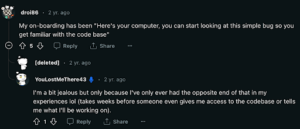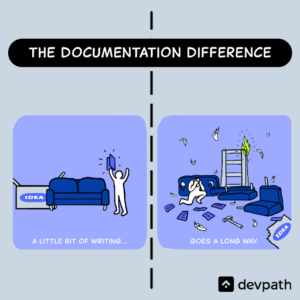
Why a 30/60/90 Onboarding Plan is Critical for Developer Team Success
You need a plan to onboard engineers onto your teams successfully. Why? Onboarding new software developer team members to become full contributors typically takes several months. In order to maintain a positive candidate experience and solidify their place on the team, it’s crucial to spend the time and energy coaching them up to speed on your product, internal processes, and coding standards. Investing in this work helps developers contribute early and often, plus it leads to greater retention down the road.
During the “The Great Resignation,” the tech industry saw a 4.5% increase in resignations during 2021 alone, and in 2022-2023, software engineers were among the 100,000 tech employees laid off.
Each developer costs upwards of $20,000 to $35,000 to become a full contributor, not to mention the incalculable amount of time consumed across your team. So, it makes sense to invest in doing it well with a solid onboard plan for engineers.
Related: How to Hire Developers
How Does Great Developer Onboarding Fit in, and Why Does it Matter?In short, developer onboarding is closely related to retention, job satisfaction, productivity, and success.
Despite pinpointing all the downstream effects of onboarding, consistently successful onboarding has a long way to go.

Source: Reddit
There is no “one-size-fits-all” onboarding solution, but there are best practices worth considering.
Hired partnered with Educative to craft an eBook to outline detailed steps to create an efficient and successful onboarding framework (along with key tactics to personalize for each employee) and a free downloadable 30/60/90 template.
Get the eBook for your customizable onboard plan for engineers on your team.
Use this as your guide to streamline the onboarding process for all your new hires.
Why a 30/60/90 Onboard Plan Determines an Engineer’s SuccessOnboarding is essential, but many organizations struggle with it, especially in remote or hybrid work environments.
Here are three key reasons you need to use a 30/60/90 plan to onboard your tech talent:
1. Increase Retention
Only 12% of U.S. employees said their company did a good job onboarding, according to Gallup analytics. One in five employees rated their experience as poor or received no onboarding at all.
On the other hand, 70% of the employees with exceptional onboarding experiences highly rated their jobs and were 2.6x more likely to be satisfied with and stay at their workplace.
Turnover is not a new challenge, but an effective onboarding program will significantly reduce high turnover rates, especially during those all-important first 90 days.
2. Clear Onboarding Milestones Define Success
What’s the reason for onboarding failure? Atul Gawande, author of “The Checklist Manifesto,” writes that there’s a clear distinction between errors of ignorance (mistakes we make because we don’t know enough) and errors of ineptitude (mistakes we make because we don’t make proper use of what we know).
Failure in developer onboarding results from both “errors of ineptitude” and “errors of ignorance.”
Engineering Managers and team leads have a lot on their plates to meet company goals. Despite having access to online resources, documentation, and personal knowledge to create a successful onboarding solution, the implementation often falls short. This is often due to limited bandwidth.
On the other hand, murky company goals or differing expectations from leadership can result in misaligned onboarding milestones due to errors of ignorance. This happens frequently in newly-created roles or those part of new initiatives.
Related: Opening a new role? Check out 5 Tips Where You Should Begin
Creating a 30/60/90 onboarding plan tackles both types of errors by capturing refined knowledge and documenting clear milestones to align expectations across the company.
3. A Mentor’s Training Defines the Onboarding Experience
It’s not entirely up to the new hire for a successful onboarding process — the mentor holds just as much responsibility.

Source: Reddit
Training is a multi-stakeholder task; documenting expectations for mentors involved in training keeps all team members on the same page and minimizes confusion from miscommunicated or unspoken expectations.
As a mentor, encourage questions and be a helpful resource during the onboarding process by setting clear expectations. It’s natural to want to impress the new team or supervisor, so some new hires may be hesitant to show ignorance or confusion OR bite off more than they can chew within the first couple of weeks.
Related: How to Foster Psychological Safety in the Workplace, from Interviews to Management
Top-of-mind Priorities in a Software Engineering 30/60/90 PlanBefore we dive into the specifics of the onboarding plan, let’s cover 3 top-of-mind priorities for your 30/60/90 plan. Think of this as an outline blueprint for what a new employee will accomplish within 90 days.
Prioritize the following elements when developing an engineering 30/60/90 plan:
- Technical Setup and Tool Familiarization
- Personalize the Process
- Team Integration & Culture
1. Technical Setup and Tool Familiarization
Set your new hire up with the tools and documentation needed to do their day-to-day tasks.
Some considerations include the following:
- Development Environment: Ensure new developers have all necessary tools installed, licenses obtained, and access granted. This includes the IDE (Integrated Development Environment), source control, databases, and other essential tools.
- Codebase Access & Overview: Grant access to the repository and provide an introduction to the codebase. A high-level architectural overview is invaluable for understanding how different components interact.
- Documentation: Point new developers to existing documentation about coding standards, design patterns, and workflows. If possible, assign a reading list for the first few days. Better yet, point your new developer to well-written code.

Source: How Docs as Code Can Supercharge My Dev Team
2. Personalize the Process
How does your onboarding plan for engineers meet your new hire’s specific needs?
Every developer enters your company at a different starting point. Joseph Gefroh, VP of Engineering at HealthSherpa, manages this by tailoring onboarding to varied learning needs and experience levels.
“A person can be great at one thing but junior in another. Identifying where your team’s individual strengths and weaknesses lie is, therefore, the key first step in leading them.” – Joseph Gefroh, VP of Engineering at HealthSherpa
Just because you’re hiring multiple people for similar roles doesn’t mean each of those tech engineers will have the same learning path. One may have completely different qualifications and require additional training modules.
Need help upskilling or refreshing a new hire’s skills? Try DevPath from Educative.
3. Team Integration and Culture
How does your engineering onboarding process include the rest of the team?
As you build your plan, note the action items required to familiarize your new hire with the team’s processes and culture.
Include items such as
- Buddy or mentor system
- Intro meetings and meeting purposes
- Company culture
- Team-specific rituals and values
- Team lunches and social events
- Feedback loops
Following the framework above, let’s dive into building your 30/60/90 onboard plan for engineers with some pre-boarding.
Pre-boarding (T-7 days)
Summary: Key Action Items for Pre-boarding Phase
|
Before a new hire’s official start date, collaborate with your HR team to ensure a smooth first week. Consider these items as the “pre-boarding” tasks:
Send or prep welcome materials
If your company supplies any type of welcome package (company swag, welcome letter, personalized items, etc.), prepare these for arrival or ship to remote employees. Add a quick message with a 1st day schedule.
Send paperwork
Are there items you need to send early to acclimate new hires (HR documents, benefits information, etc.)? Give them a heads up of documents or types of IDs they’ll need to bring/send. If they’re completing tax or other government forms remotely, provide a sample of a completed version to guide them.
Company overview
Send key company information, such as main mission, values, goals (annual and overall), history, or need-to-know operational details.
Prep Equipment
Work with your IT team to set up a workstation or ship all necessary equipment and hardware (laptop, mouse, keyboard, headset, chargers, adapters, etc.). Be sure to complete this well before their first day in case of delays. Nothing’s worse than a new team member without equipment on Day 1.

Source: DevPath
You’re Ready to Welcome Your New Developer or Engineer and begin a strong onboard plan!Related: Recruiting Software Platforms: What You Need to Know
Congratulations, you’ve done the work to plan and prepare for a great onboarding experience for developers on your team.
Grab actionable steps for the first three months and a professional template (for free) by downloading your free 30/60/90 onboard plan for engineers:
Originally published Dec. 8, 2021. Updated by Hired Content Team and Educative on September 18, 2023
Related blog posts

How to Onboard Successfully & More: Talk Talent to Me December ’22 Recap
Catch up on the December 2022 episodes of Hired’s Talk Talent to Me podcast featuring...

How to Onboard Remote Employees Really Well: Free Checklist Template
What You’ll Learn Things you should do before a new employee’s first day...

4 Ways to Keep Company Culture Alive in Remote & Hybrid Work
After a surge of remote work, employers seem to be less flexible these days. Fewer roles are...

Best Practices for Onboarding Hybrid Roles (A Complete Checklist)
About this Checklist Before COVID-19, employees spent most of their time in the office—but...

Hire Globally, Act Locally: Enabling Success for a Remote First Workforce (Video)
Key Takeaways from Hired CEO Josh Brenner and Oyster CEO Tony Jamous at the Hired Summit The...

Awareness to Action: How to Build a Fair and Inclusive Hiring Process (VIDEO)
How do you eliminate bias from the recruitment process? Watch this on-demand webinar to hear...

